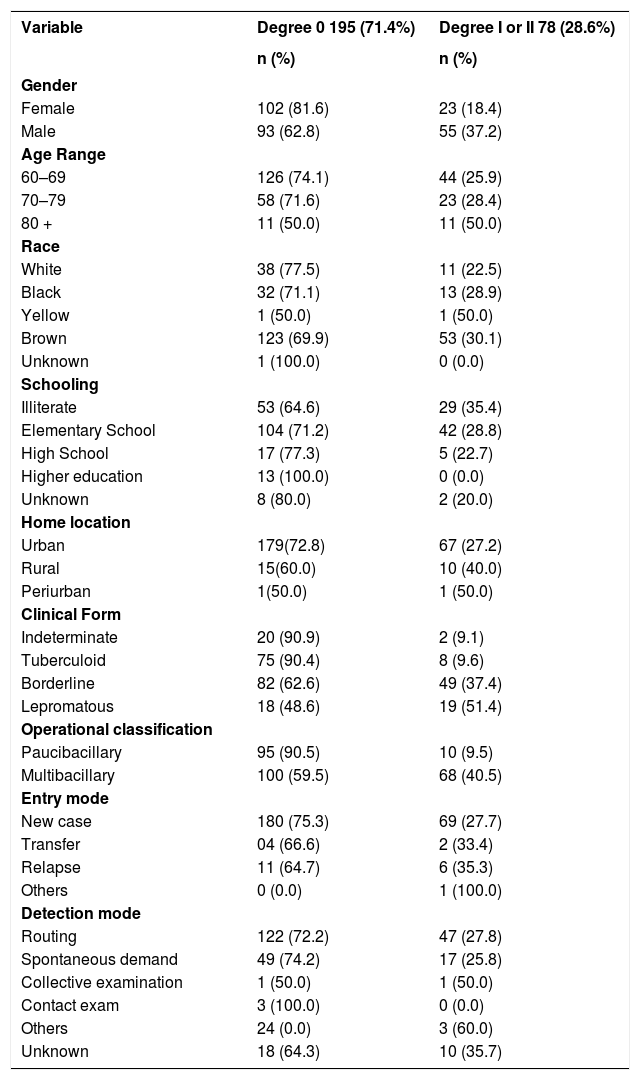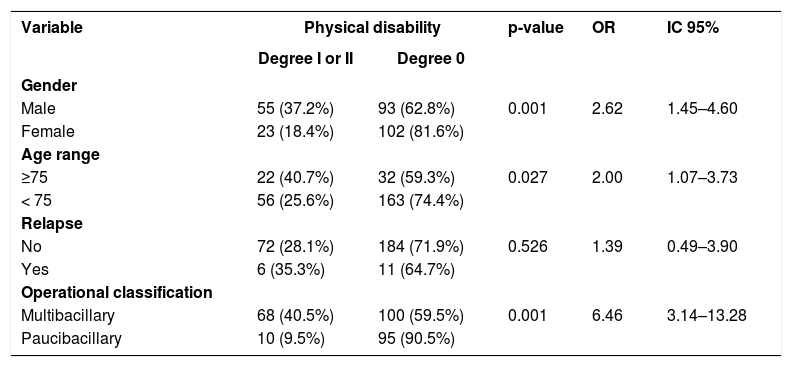Dear Editor,
Leprosy continues to be an important public health problem in many developing countries, particularly Brazil.1 Although the number of leprosy cases has declined in recent decades, more than 25,000 new cases were diagnosed throughout the country in 2016 alone.2 Furthermore, recent studies have argued that there are far more cases that remain undiagnosed.3
Brazil has undergone a drastic demographic transition. The reduction of mortality rates and subsequent increase in life expectancy, in conjunction with reduced fertility rates, are factors that have contributed to the aging of the population.4
This double scenario, characterized concurrently by the persistence of the disease and the aging of the population, suggests that leprosy is a real health problem among elderly people. Additional aspects that further corroborate the need for reflection on this subject include the incapacitating potential of leprosy and the lower immunological competence of elderly people. Concern about the occurrence of physical disabilities has been highlighted. One of the three main goals of the "Global Leprosy Strategy 2016–2020", established by the World Health Organization (WHO), is the reduction of new cases of grade II leprosy to less than one case per million inhabitants.1
Thus, all cases of leprosy diagnosed and reported among the elderly population (age 60 or older) at the reference center in the city of Juazeiro, Bahia, Brazil between 2010 and 2016 were included in this study, which seeks to describe the occurrence of physical disabilities and stimulate reflection on this problem.
The following variables were analyzed: municipality of residence, degree of physical incapacity at diagnosis, sex, age, race, level of schooling, area of residence, clinical form, operational classification, entry mode, and detection mode. A simple descriptive analysis of these variables was carried out, and the logistic regression model was used to identify factors associated with the degree of physical disability in order to calculate the odds ratio (OR). Confidence interval and p-value were set at 95% and <0.05, respectively.
Among the 273 elderly individuals diagnosed, 28.6% were diagnosed with some type of disability. The proportion of elderly males with disability was almost 2.6 times higher than that of women. The proportion of elderly people with disabilities increased with age, as well as with low level of schooling in both sexes (Table 1).
Sociodemographic and clinical characterization of leprosy cases diagnosed in elderly people at the Dr Altino Lemos Santiago Reference Center, Juazeiro, Bahia, Brazil, 2010–2016
| Variable | Degree 0 195 (71.4%) | Degree I or II 78 (28.6%) |
|---|---|---|
| n (%) | n (%) | |
| Gender | ||
| Female | 102 (81.6) | 23 (18.4) |
| Male | 93 (62.8) | 55 (37.2) |
| Age Range | ||
| 60–69 | 126 (74.1) | 44 (25.9) |
| 70–79 | 58 (71.6) | 23 (28.4) |
| 80 + | 11 (50.0) | 11 (50.0) |
| Race | ||
| White | 38 (77.5) | 11 (22.5) |
| Black | 32 (71.1) | 13 (28.9) |
| Yellow | 1 (50.0) | 1 (50.0) |
| Brown | 123 (69.9) | 53 (30.1) |
| Unknown | 1 (100.0) | 0 (0.0) |
| Schooling | ||
| Illiterate | 53 (64.6) | 29 (35.4) |
| Elementary School | 104 (71.2) | 42 (28.8) |
| High School | 17 (77.3) | 5 (22.7) |
| Higher education | 13 (100.0) | 0 (0.0) |
| Unknown | 8 (80.0) | 2 (20.0) |
| Home location | ||
| Urban | 179(72.8) | 67 (27.2) |
| Rural | 15(60.0) | 10 (40.0) |
| Periurban | 1(50.0) | 1 (50.0) |
| Clinical Form | ||
| Indeterminate | 20 (90.9) | 2 (9.1) |
| Tuberculoid | 75 (90.4) | 8 (9.6) |
| Borderline | 82 (62.6) | 49 (37.4) |
| Lepromatous | 18 (48.6) | 19 (51.4) |
| Operational classification | ||
| Paucibacillary | 95 (90.5) | 10 (9.5) |
| Multibacillary | 100 (59.5) | 68 (40.5) |
| Entry mode | ||
| New case | 180 (75.3) | 69 (27.7) |
| Transfer | 04 (66.6) | 2 (33.4) |
| Relapse | 11 (64.7) | 6 (35.3) |
| Others | 0 (0.0) | 1 (100.0) |
| Detection mode | ||
| Routing | 122 (72.2) | 47 (27.8) |
| Spontaneous demand | 49 (74.2) | 17 (25.8) |
| Collective examination | 1 (50.0) | 1 (50.0) |
| Contact exam | 3 (100.0) | 0 (0.0) |
| Others | 24 (0.0) | 3 (60.0) |
| Unknown | 18 (64.3) | 10 (35.7) |
Source: SINAN NET - municipal database July 2017
At the same time, an increase in the proportion of physical disabilities was associated with multibacillary forms of the disease (borderline and lepromatous). Of the individuals with multibacillary operational classification, 40.5% already had some degree of disability, compared to only 9.5% in paucibacillary cases (Table 1). This confirms that the higher the bacillary load, the greater the risk of neural damage and physical incapacities.
Regarding entry mode, 75.3% of new cases did not present any physical incapacity at the moment of diagnosis. With respect to this variable, relapsed entry deserves attention. Notwithstanding the fact that it represented only 6.0% of cases, more than one third of these presented some degree of disability (Table 1).
Regarding mode of detection, referrals (61.9%) and spontaneous demand (24.2%) stood out. When analyzed according to the presence of disability, two facts deserve attention. The first one concerns the contact test, in which none of the subjects presented any incapacity; however, this mode is not very expressive, representing only 1.1% of the total cases. This finding reinforces the idea that early diagnosis prevents the occurrence of disability. The second fact relates to the number of ignored or blank fields, which totaled 10.2% (Table 1).
The logistic regression analysis showed an association between physical disability and the following variables: gender (OR 2.62, p = 0.001), age group (OR 2.00, p = 0.027), and operational classification (OR 6.46, p = 0.001), thus reinforcing the aforementioned findings (Table 2).
Logistic regression having as a dependent variable the presence or absence of physical disability in the diagnosis among leprosy cases diagnosed in the elderly at the Dr. Altino Lemos Santiago Reference Center, Juazeiro, Bahia, Brazil, 2010–2016
| Variable | Physical disability | p-value | OR | IC 95% | |
|---|---|---|---|---|---|
| Degree I or II | Degree 0 | ||||
| Gender | |||||
| Male | 55 (37.2%) | 93 (62.8%) | 0.001 | 2.62 | 1.45–4.60 |
| Female | 23 (18.4%) | 102 (81.6%) | |||
| Age range | |||||
| ≥75 | 22 (40.7%) | 32 (59.3%) | 0.027 | 2.00 | 1.07–3.73 |
| < 75 | 56 (25.6%) | 163 (74.4%) | |||
| Relapse | |||||
| No | 72 (28.1%) | 184 (71.9%) | 0.526 | 1.39 | 0.49–3.90 |
| Yes | 6 (35.3%) | 11 (64.7%) | |||
| Operational classification | |||||
| Multibacillary | 68 (40.5%) | 100 (59.5%) | 0.001 | 6.46 | 3.14–13.28 |
| Paucibacillary | 10 (9.5%) | 95 (90.5%) | |||
Source: SINAN NET - municipal database July 2017
The results obtained in this study suggest the existence of a relationship between leprosy in the elderly population and the occurrence of physical disabilities. This study observed the following: the presence of some degree of physical incapacity in one third of patients at the time of diagnosis; an increased proportion of cases accompanying advanced age and low level of schooling; the prevalence of multibacillary forms; and, finally, a higher frequency of leprosy in males.
In view of the above, it should be noted that the increase in the number of leprosy cases in the growing elderly population will require that healthcare providers implement specific actions in their areas of care, and that public policies address this issue with programs to control leprosy.5





